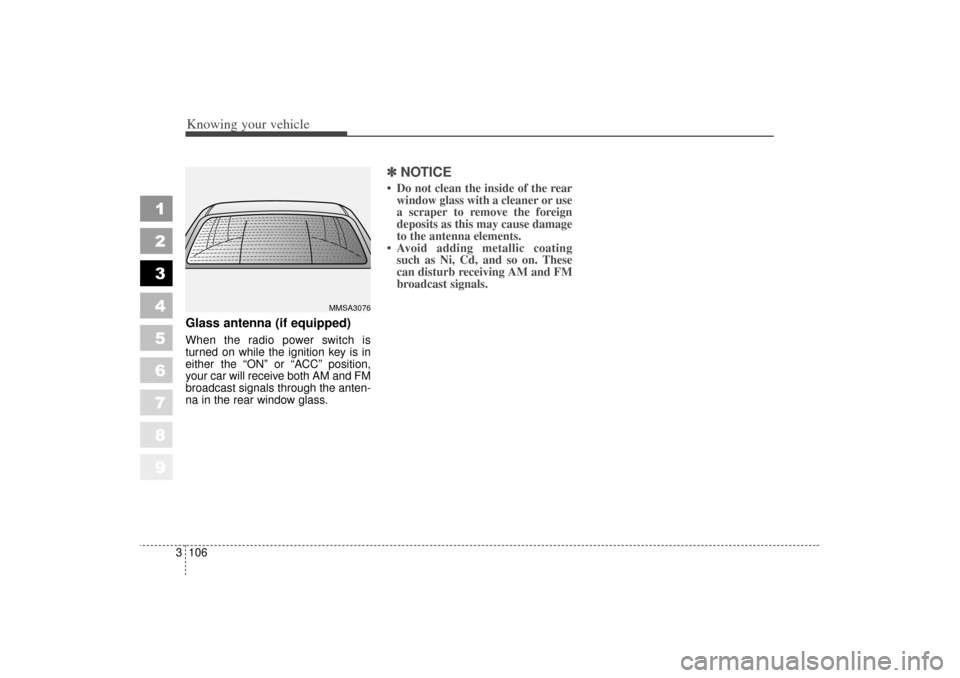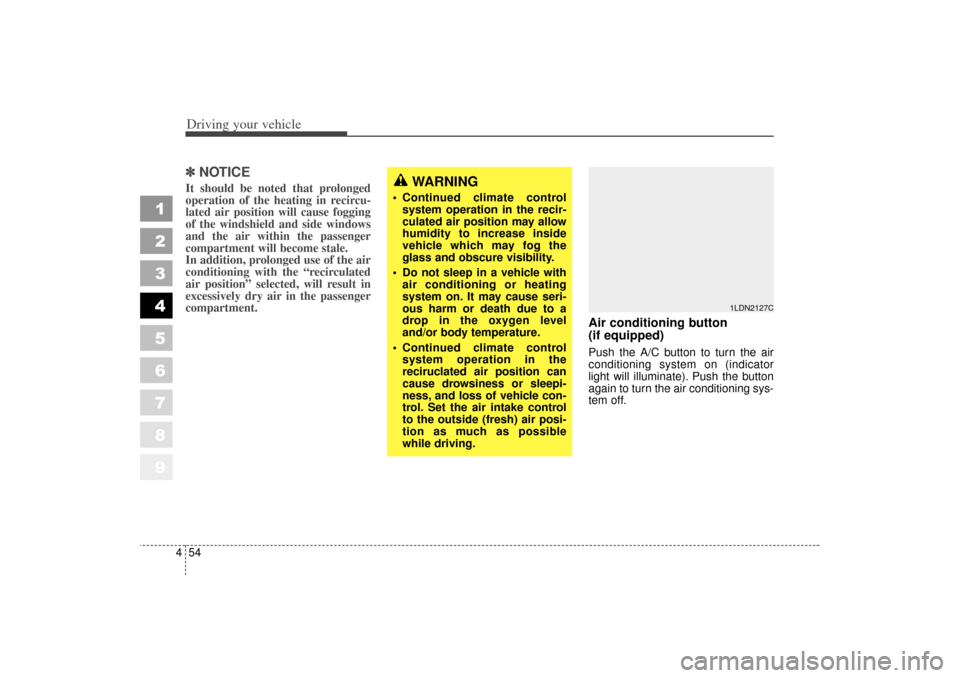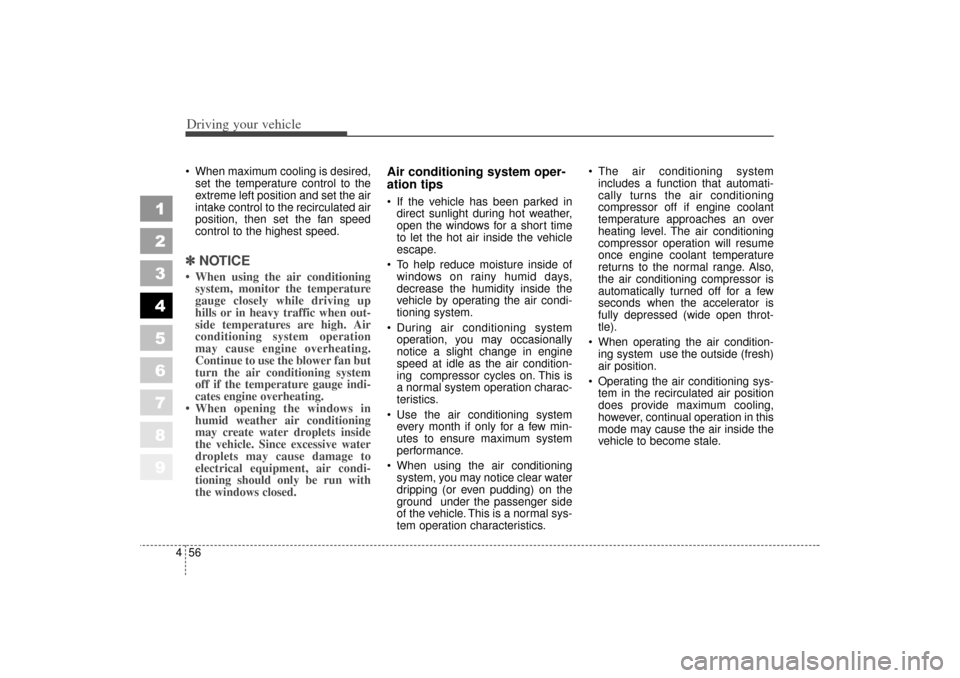window KIA Sephia 2006 2.G User Guide
[x] Cancel search | Manufacturer: KIA, Model Year: 2006, Model line: Sephia, Model: KIA Sephia 2006 2.GPages: 273, PDF Size: 2.83 MB
Page 79 of 273

Knowing your vehicle68
3
1
2
3
4
5
6
7
8
9
Curtain airbag (if equipped)Curtain airbags are located along
both sides of the roof rails above the
front and rear doors.
They are designed to help protect the
heads of the front seat occupants
and the rear outboard seat occupants
in certain side impact collisions.
If the curtain airbag deploys, it
remains inflated for approximately 3
seconds. The curtain airbag deploy-
ment occurs only on the side of the
vehicle affected by the impact.
The side airbags (side and curtain
airbags) are not designed to deploy
during collisions from the front or
rear of the vehicle or in most rollover
situations.
The curtain airbags are designed to
deploy only during certain side-
impact collisions, depending on the
crash severity, angle, speed and
impact. The curtain airbags are not
designed to deploy in all side impact
situations.
WARNING
In order for side airbags (side
and curtain airbags) to pro-
vide its best protection, both
front seat occupants and both
outboard rear occupants
should sit in an upright posi-
tion with the seat belts proper-
ly fastened. Especially, chil-
dren should sit in a proper
child restraint system.
(Continued)
(Continued)
When children are seated inthe rear outboard seats, they
must be seated in the proper
child restraint system. Make
sure to put the child restraint
system as far away from the
door side as possible, and
secure the child restraint sys-
tem to be locked in position.
Do not allow the passengers to lean their heads or bodies
onto doors, put their arms on
the doors, stretch their arms
out of the window, or place
objects between the doors
and passengers when they are
seated on the seats where
side airbags are equipped.
Never try to open or repair any components of the side cur-
tain airbag system. This
should be done only by an
authorized Kia dealer.
Failure to follow the above men-
tioned instructions can result in
injury or death to the vehicle
occupants in an accident.
1LDA20521LDA2057
LD CAN (ENG) new 3-1~.qxd 7/29/05 10:29 AM Page 68
Page 99 of 273

Knowing your vehicle88
3
1
2
3
4
5
6
7
8
9
Manual remote control
(if equipped)
To adjust an outside mirror, move the
control lever located at the forward
inside area of the window frame. Electric remote control
(if equipped)
The electric remote control mirror
switch allows you to adjust the posi-
tion of the left and right outside
rearview mirrors. To adjust the posi-
tion of either mirror, move the lever
(
➀) to R or L to select the right side
mirror or the left side mirror, then
press a corresponding point ( ) on
the mirror adjustment control to posi-
tion the selected mirror up, down, left
or right.
After adjustment, put the lever into
neutral position to prevent the inad-
vertent adjustment.
✽ ✽ NOTICE The mirrors stop moving when
they reach the maximum adjust-
ing angles, but the motor contin-
ues to operate while the switch is
depressed. Do not depress the
switch longer than necessary, the
motor may be damaged.
Do not attempt to adjust the out- side rearview mirror by hands.
Doing so may damage the parts.
1LDN2080
➀
1LDA2081
LD CAN (ENG) 3-84~.qxd 7/29/05 10:15 AM Page 88
Page 100 of 273

389
1
2
3
4
5
6
7
8
9
Knowing your vehicle
Folding the outside rearview
mirror
Manual type
To fold outside rearview mirror, grasp
the housing of mirror and then fold it
toward the rear of the vehicle.Outside rearview mirror heater
(if equipped)
The outside rearview mirror heater is
actuated in connection with the rear
window defroster. To heat the outside
rearview mirror glass, push the but-
ton for the rear window defroster.
The outside rearview mirror glass will
be heated for defrosting or defogging
and will give you improved rear
vision in inclement weather condi-
tions. Push the button again to turn
the heater off. The outside rearview
mirror heater automatically turns off
after 20 minutes.
Day/night rearview mirror Adjust the rearview mirror to center
on the view through the rear window.
Make this adjustment before you
start driving.
1LDA2083
CAUTION
Do not place objects in the rear
seat or cargo area which would
interfere with your vision out
the rear window.
LD CAN (ENG) 3-84~.qxd 7/29/05 10:15 AM Page 89
Page 109 of 273

Knowing your vehicle98
3
1
2
3
4
5
6
7
8
9
Front
Cups or small beverage cans may be
placed in the cup holders. Rear (if equipped)
To use the cup holders in rear seat,
pull the rear cup holder cover (
➀)
out. Push the cover to close after
use.
✽ ✽ NOTICEDo not place heavy cups or cans in
cup holders. Cup holders could be
damaged.
SunvisorUse the sunvisor to shield direct light
through the front or side windows.
To use a sunvisor, pull it downward.
To use a sunvisor for a side window,
pull it downward, unsnap it from the
bracket (
➀) and swing it to the side.
To use the vanity mirror, pull down
the visor and pull up the mirror cover
(
➁).
1LDA2161
1LDN2151
1LDA2160
LD CAN (ENG) 3-84~.qxd 7/29/05 10:15 AM Page 98
Page 117 of 273

Knowing your vehicle106
3
1
2
3
4
5
6
7
8
9
Glass antenna (if equipped)When the radio power switch is
turned on while the ignition key is in
either the “ON” or “ACC” position,
your car will receive both AM and FM
broadcast signals through the anten-
na in the rear window glass.
✽ ✽
NOTICE Do not clean the inside of the rear
window glass with a cleaner or use
a scraper to remove the foreign
deposits as this may cause damage
to the antenna elements.
Avoid adding metallic coating such as Ni, Cd, and so on. These
can disturb receiving AM and FM
broadcast signals.
MMSA3076
LD CAN (ENG) 3-84~.qxd 7/29/05 10:15 AM Page 106
Page 152 of 273

435
1
2
3
4
5
6
7
8
9
Driving your vehicle
If the driver’s lap/shoulder belt is not
fastened within 30 seconds after the
engine is started, the safety belt
warning light will blink for 6 seconds.
This cycle will repeat 11 times with
an interval of 24 seconds between
cycles.
If the system does not operate as
described, see an authorized Kia
dealer for assistance.
Rear window defroster
indicator (if equipped) This light comes on when the rear
defroster switch is depressed to
remove the frost on the rear glass.
Press the switch again to shut off the
defroster when the frost is removed.
The rear window defroster will auto-
matically turn off after 20 minutes.
It will also turn off whenever you
remove the ignition key.Shift pattern indicators
(if equipped)The individual indicators illuminate to
show the automatic transaxle shift
lever selection.
Immobilizer indicator
(if equipped)This light illuminates when the immo-
bilizer key is inserted and turned to
the ON position to start the engine.
If this light turns off or blinks when
the ignition switch is in the ON posi-
tion before starting the engine, have
the system checked by an authorized
Kia Dealer.
LD CAN (ENG) 4.qxd 7/29/05 10:17 AM Page 35
Page 164 of 273

447
1
2
3
4
5
6
7
8
9
Driving your vehicle
The defroster heats the window to
remove frost, fog and thin ice from
the interior and exterior of the rear
window, while engine is running.
✽ ✽NOTICE To prevent damage to the conduc-
tors bonded to the inside surface
of the rear window, never use
sharp instruments or window
cleaners containing abrasives to
clean the window.
To prevent the battery from being discharged, operate the defroster
only while the engine is running.
If you want to defrost and defog on the front windshield, refer to
“Windshield Defrosting and
Defogging” in this section.
To activate the rear window
defroster, press the rear window
defroster button located in the center
console switch panel. The indicator
in the instrument cluster illuminates
when the defroster is ON.
If your vehicle is equipped with the
outside mirror defroster, it will be
operating at the same time when you
operate the rear window defroster.
If there is heavy accumulation of
snow on the rear window, brush it off
before operating the rear defroster.
The rear window defroster automati-
cally turns off after 20 minutes or
when the ignition switch is turned off.
To turn off the defroster, press the
rear window defroster button again.
DEFROSTER
1LDN2116A1LDN2116
4 Door5 Door
LD CAN (ENG) 4.qxd 7/29/05 10:17 AM Page 47
Page 169 of 273

Driving your vehicle52
4
1
2
3
4
5
6
7
8
9
Face position
Air flow is directed towardthe upper body and face.
Additionally, each outlet
can be controlled to direct
the air discharged from
the outlet.
(outlet port: , )
Face - floor position Air flow is directedtowards the face and the
floor. The air to the floor is
warmer than the air to the
face (except when the
temperature control is set
to the extreme cold posi-
tion).
(outlet port: , , , )
OFF position The climate control sys-
tem is turned off. Floor position
Most of the air flow is
directed to the floor, with a
small amount of the air
being directed to the wind-
shield and side window
defroster. (outlet port: ,, , , )
Floor - defrost position
Most of the air flow is
directed to the floor and
the windshield with a
small amount directed to
the side window
defrosters. (outlet port: ,, , , )
Defrost position
Most of the air flow is
directed to the windshield
with a small amount of air
directed to the side win-
dow defrosters.
(outlet port: , , )
Instrument panel ventsIf air flow control is not satisfactory,
check the instrument panel vents.
The outlet port ( , ) can be opened
or closed separately using the verti-
cal thumbwheel. To close the vent,
rotate it upward to the maximum
position. To open the vent, rotate it
downward.
Also, you can adjust the direction of
air delivery from these vents using
vertical or horizontal thumbwheels
as shown.
BB
C
E
F
A
C
D
E
F
F
OFF
A
C
D
E
FA
D
F
1LDN2122A
B
F
LD CAN (ENG) 4.qxd 7/29/05 10:17 AM Page 52
Page 171 of 273

Driving your vehicle54
4
1
2
3
4
5
6
7
8
9
✽ ✽
NOTICEIt should be noted that prolonged
operation of the heating in recircu-
lated air position will cause fogging
of the windshield and side windows
and the air within the passenger
compartment will become stale.
In addition, prolonged use of the air
conditioning with the “recirculated
air position” selected, will result in
excessively dry air in the passenger
compartment.
Air conditioning button
(if equipped) Push the A/C button to turn the air
conditioning system on (indicator
light will illuminate). Push the button
again to turn the air conditioning sys-
tem off.
WARNING
Continued climate control
system operation in the recir-
culated air position may allow
humidity to increase inside
vehicle which may fog the
glass and obscure visibility.
Do not sleep in a vehicle with
air conditioning or heating
system on. It may cause seri-
ous harm or death due to a
drop in the oxygen level
and/or body temperature.
Continued climate control
system operation in the
reciruclated air position can
cause drowsiness or sleepi-
ness, and loss of vehicle con-
trol. Set the air intake control
to the outside (fresh) air posi-
tion as much as possible
while driving.
1LDN2127C
LD CAN (ENG) 4.qxd 7/29/05 10:17 AM Page 54
Page 173 of 273

Driving your vehicle56
4
1
2
3
4
5
6
7
8
9
When maximum cooling is desired,
set the temperature control to the
extreme left position and set the air
intake control to the recirculated air
position, then set the fan speed
control to the highest speed.✽ ✽
NOTICE When using the air conditioning
system, monitor the temperature
gauge closely while driving up
hills or in heavy traffic when out-
side temperatures are high. Air
conditioning system operation
may cause engine overheating.
Continue to use the blower fan but
turn the air conditioning system
off if the temperature gauge indi-
cates engine overheating.
When opening the windows in humid weather air conditioning
may create water droplets inside
the vehicle. Since excessive water
droplets may cause damage to
electrical equipment, air condi-
tioning should only be run with
the windows closed.
Air conditioning system oper-
ation tips If the vehicle has been parked in
direct sunlight during hot weather,
open the windows for a short time
to let the hot air inside the vehicle
escape.
To help reduce moisture inside of
windows on rainy humid days,
decrease the humidity inside the
vehicle by operating the air condi-
tioning system.
During air conditioning system
operation, you may occasionally
notice a slight change in engine
speed at idle as the air condition-
ing compressor cycles on. This is
a normal system operation charac-
teristics.
Use the air conditioning system
every month if only for a few min-
utes to ensure maximum system
performance.
When using the air conditioning
system, you may notice clear water
dripping (or even pudding) on the
ground under the passenger side
of the vehicle. This is a normal sys-
tem operation characteristics.
The air conditioning system
includes a function that automati-
cally turns the air conditioning
compressor off if engine coolant
temperature approaches an over
heating level. The air conditioning
compressor operation will resume
once engine coolant temperature
returns to the normal range. Also,
the air conditioning compressor is
automatically turned off for a few
seconds when the accelerator is
fully depressed (wide open throt-
tle).
When operating the air condition-
ing system use the outside (fresh)
air position.
Operating the air conditioning sys-
tem in the recirculated air position
does provide maximum cooling,
however, continual operation in this
mode may cause the air inside the
vehicle to become stale.
LD CAN (ENG) 4.qxd 7/29/05 10:17 AM Page 56